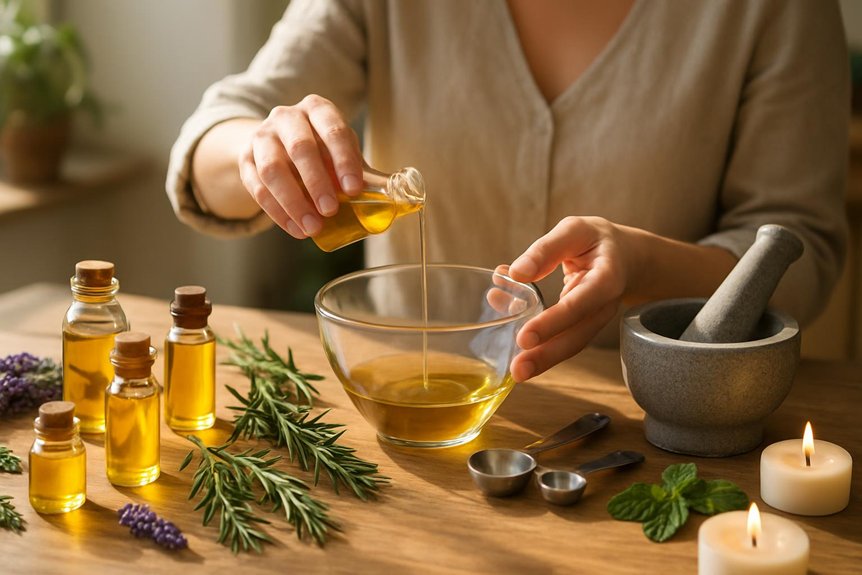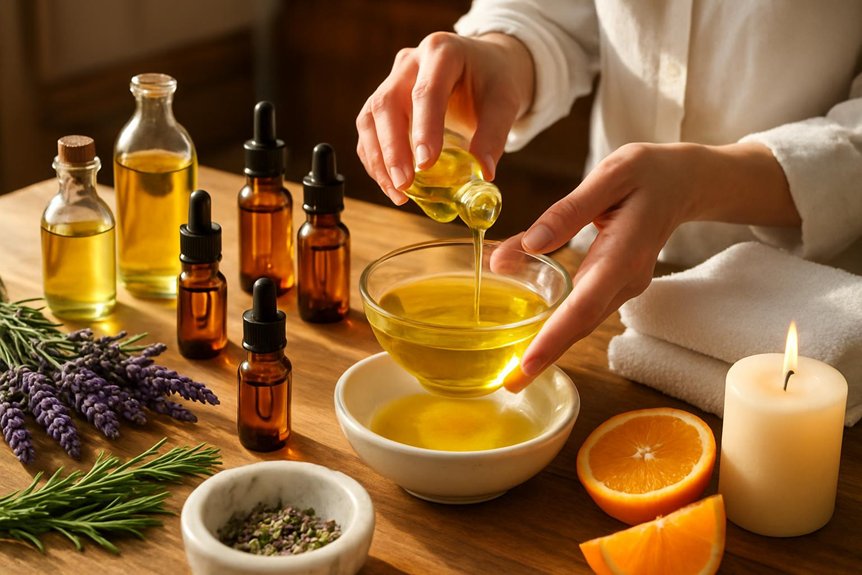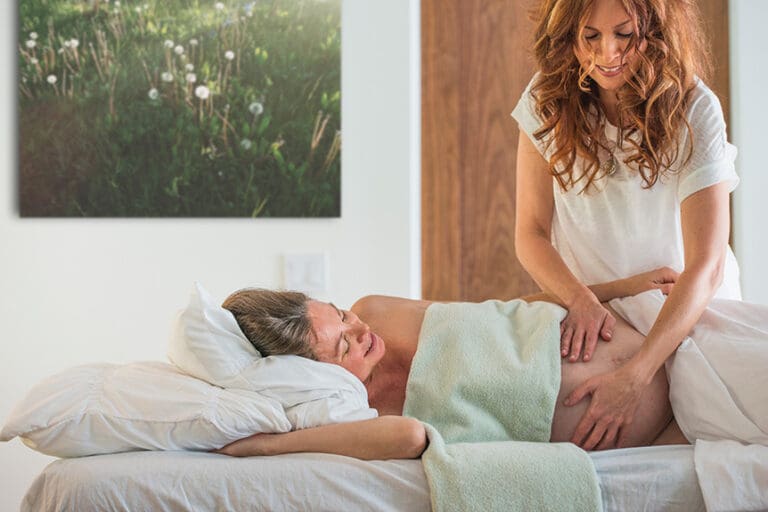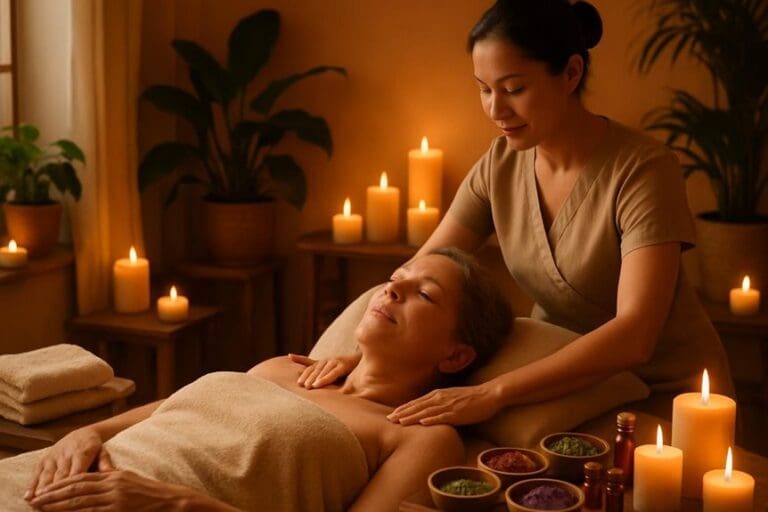To make essential massage oils, select evidence-backed essential oils (e.g., lavender, peppermint, eucalyptus) and a well-tolerated carrier (fractionated coconut, jojoba, sweet almond). Dilute to 2% for healthy adults (12 drops per 30 mL carrier); use 1% or 0.5–1% for pregnancy, older adults, or sensitive skin. Avoid phototoxic citrus above 0.4% and known irritants. Patch test a 1% blend on the inner forearm for 24–48 hours. Store oils cool and dark. Practical blend recipes and application tips follow.
Understanding Essential Oils and Their Effects

Essential oils are concentrated, volatile plant extracts containing bioactive compounds (e.g., terpenes, phenols, esters) that can influence the nervous, musculoskeletal, and integumentary systems via olfactory pathways and topical absorption.
In clinical use at Spa & Massage, selection centres on desired outcomes and tolerability. Linalool-rich lavender may modulate autonomic arousal; citrus oils with limonene can uplift mood; eucalyptus and rosemary, high in 1,8-cineole, support clear breathing and perceived muscular ease. Potent phenolics (e.g., eugenol) require conservative dosing to reduce sensitisation risk.
Therapists emphasise patch testing and low concentrations to respect skin barrier integrity and deepen comfort. Phototoxicity from certain expressed citrus oils is addressed by avoiding pre-sun exposure.
Clients are advised to store oils cool, dark, and sealed, and to discontinue use with any irritation or headache. For further relaxation and well-being, you may also benefit from learning professional aromatherapy massage techniques.
Choosing Safe Carrier Oils for Massage
A suitable carrier oil underpins both efficacy and skin tolerance in aromatic massage, diluting essential oils to safe concentrations while providing glide, occlusivity, and nutrient profiles.
Selection should prioritise dermatological tolerance, oxidative stability, and comedogenic potential. For most skins, sweet almond and fractionated coconut offer light glide and low sensitisation risk; jojoba (a liquid wax) mimics sebum, supporting barrier integrity; grapeseed suits those preferring a dry finish but oxidises faster.
For reactive or fragrance‑sensitive clients, cold‑pressed apricot kernel or sunflower (high‑oleic) are gentle options.
At Spa & Massage, therapists screen for nut allergies, eczema, and acneiform tendencies before choosing a base.
They rotate fresh, antioxidant‑rich oils, store them cool and dark, and avoid photosensitising or strongly aromatic carriers, keeping touch silky, breathable, and intimately safe.
Dilution Guidelines Our Therapists Trust
Spa & Massage sets dilution as a clinical safety step: typically 1–2% total essential oil for healthy adults (6–12 drops per 30 ml carrier), with 0.5–1% for pregnancy, older adults, and sensitive skin.
Carrier selection remains foundational—neutral, stable oils such as sweet almond, fractionated coconut, or grapeseed support even dispersion and reduce irritancy.
Therapists also screen for age, dermatologic conditions, asthma, epilepsy, medication use, and photosensitising oils (e.g., certain citruses), adjusting concentrations or avoiding specific constituents accordingly.
Safe Dilution Ratios
For safe, effective essential massage oils, dilution is calculated as a percentage of essential oil in a carrier, with most adults tolerating 1–3% for full‑body massage (roughly 6–18 drops essential oil per 30 ml carrier). Spa & Massage therapists apply 0.5–1% for facial areas, neck, and décolletage; 3–5% is reserved for brief, localised application to tense muscles. Sensitive skin, older adults, and those new to aromatherapy remain at 0.5–1%.
Pregnancy, breastfeeding, and certain health conditions warrant medical guidance and a 0.5–1% maximum, with several oils contraindicated.
Patch testing is essential: apply a 1% blend to the inner forearm, observe 24 hours.
Use accurate measuring—graduated pipettes, scales, or teaspoon equivalents.
Lower dilutions sustain intimacy: scent lingers, touch stays comfortable, and skin barrier remains uncompromised.
Choosing Carrier Oils
Once dilution is set, efficacy and skin comfort depend on the carrier oil’s chemistry.
Spa & Massage therapists prioritise oils with stable fatty-acid profiles, low sensitisation risk, and suitable glide for slow, attentive touch.
For a neutral base, fractionated coconut oil offers excellent slip, rapid absorption, and long shelf stability (low oxidation).
Sweet almond provides a plush glide and mild occlusion; it suits most skin but is unsuitable for nut allergies.
Jojoba (a liquid wax) mimics skin sebum, enhancing barrier support and reducing trans-epidermal water loss—ideal for intimate relaxation without greasiness.
Grapeseed is light, has a clean-feel, but oxidises faster; blend with 10–20% jojoba or add vitamin E to improve stability.
In our clinics, therapists match carrier choice to texture preference, skin sensitivity, and session length to protect skin while deepening connection.
Age and Health Cautions
Age, pregnancy status, and medical history determine how strong an essential oil blend should be—and whether certain oils should be avoided altogether. At Spa & Massage, therapists follow conservative dilutions: 0.25–0.5% for infants (under professional guidance only), 1% for children, frail adults, and older clients, 1–2% for general wellness massage, and 3% only for localized, short-term use. Pregnancy requires 1% or less; avoid salicylate-rich oils (wintergreen), ketone-rich oils (sage, rosemary camphor chemotype), and emmenagogues.
Clients with asthma, epilepsy, cardiovascular disease, diabetes, or anticoagulant use need screening; avoid high 1,8-cineole during active wheeze and methyl salicylate with anticoagulants. Conduct a 24-hour patch test.
Phototoxic citrus oils (expressed bergamot, lime) demand post-massage UV avoidance. In our clinics, therapists document sensitivities, adjust dosage, and monitor cumulative exposure.
Tools, Hygiene, and Storage Basics
A well-prepared workspace underpins safe, effective aromatherapy oil blending. Spa & Massage recommends using non-reactive tools: glass beakers, stainless-steel funnels, and amber or cobalt glass bottles with dropper or pump tops.
Precision scales and graduated pipettes are essential to ensure accurate dilution, which is typically 1–3% for adults.
Surfaces should be disinfected; hands washed; tools sterilised with isopropyl alcohol and air-dried.
Cross-contamination is avoided by dedicating pipettes to single essential oils and labelling immediately with INCI names, dilution, date, and batch.
Oxidation is minimised by filling bottles to the shoulder, sealing tightly, and limiting headspace.
Storage follows clinic practice: keep oils cool (15–20°C), dark, and dry.
Adding vitamin E (0.1%) to carrier oils can help slow rancidity.
Observe shelf life—most blends last 6–12 months; citrus oils oxidise faster.
Dispose of any oil that changes odour, colour, or viscosity.
Blends for Relaxation, Energy, and Focus
Why do certain essential oil combinations reliably influence mood states? Synergy. Specific chemotypes engage olfactory receptors, modulate limbic activity, and shape autonomic tone.
For relaxation, Spa & Massage therapists favour linalool- and linalyl acetate–rich oils: lavender, Roman chamomile, and bergamot—diluted at 1.5–2% in sweet almond or grapeseed.
For grounding intimacy, a drop of vetiver or cedarwood adds sesquiterpene depth.
For energy, citrus top notes (sweet orange, grapefruit) with rosemary cineole or peppermint increase alertness; keep total dilution at 1–2% to avoid irritation.
For focus, combine rosemary cineole with lemon and a trace of frankincense; diffuse or apply to shoulders only.
Always patch test, avoid photosensitising bergamot or expressed citrus on exposed skin, and reduce dilutions during pregnancy.
Recipes for Muscle Relief and Post-Workout Care
For muscle relief blends, Spa & Massage therapists prioritise evidence-supported essential oils such as lavender, rosemary, peppermint, black pepper, and eucalyptus for their analgesic, antispasmodic, and circulatory effects.
Safety is guided by precise dilution: typically 2% (12 drops per 30 ml carrier) for general use, up to 3% for short-term post-exercise care on intact skin, with lower concentrations for sensitive areas or pregnancy.
Post-workout application focuses on gentle effleurage toward the heart, targeted friction on tight bands, and a 12–24 hour patch test.
In our clinics, therapists recommend hydration, light stretching, and avoiding heat on acute strains.
Essential Oil Choices
Curiously, selecting essential oils for muscle relief and post‑workout care benefits from an evidence‑informed approach that balances efficacy with dermal safety. Spa & Massage therapists prioritise oils with myorelaxant, anti‑inflammatory, and circulation‑supportive properties while avoiding sensitising chemotypes.
Peppermint (menthol-rich) offers cooling analgesia; wintergreen (methyl salicylate) is potent but best reserved for brief, local applications and avoided with salicylate sensitivity. Lavender (Lavandula angustifolia) provides anxiolytic and gentle antispasmodic effects, complementing slow, restorative strokes. Sweet marjoram and Roman chamomile reduce muscle guarding. Eucalyptus radiata supports post‑effort breathing comfort.
Black pepper and ginger enhance warmth and microcirculation, suited to pre‑stretch routines.
In our clinics, therapists often pair lavender + peppermint for soothing contrast, or black pepper + ginger for targeted warmth, adjusting selections to client history, medication use, and scent preference.
Safe Dilution Ratios
A safe dilution framework underpins every aromatherapy blend prepared for muscle relief and post‑workout care, and Spa & Massage therapists adhere to evidence‑based ranges to protect skin integrity while achieving therapeutic effect.
For healthy adults, 2% total essential oils (12 drops per 30 ml carrier) is the clinic standard; 3% (18 drops/30 ml) may be used short‑term for localized muscle discomfort.
Sensitive skin or older adults: 1% (6 drops/30 ml). Pregnant clients, or those with dermatologic conditions: 0.5–1%, pending individual assessment.
Irritant-prone oils (e.g., cinnamon bark, oregano) are excluded.
Strong yet gym‑friendly actives—peppermint, black pepper, rosemary ct. cineole, ginger—are capped at 1–2% combined.
Phototoxic citrus (expressed bergamot, lemon) remains ≤0.4%.
Patch testing is mandatory.
In our clinics, dilution calculations, contraindication screening, and carrier selection (sweet almond, fractionated coconut, grapeseed) are standardised for consistent comfort.
Post-Workout Application Tips
Post‑workout aromatherapy blends are most effective when applied within 30–60 minutes of exercise, targeting warm tissues to support circulation, reduce perceived muscle soreness, and aid recovery.
In our clinics, therapists recommend a gentle shower, then light towel-drying to preserve residual heat. Apply a 2% dilution in a non-comedogenic carrier (fractionated coconut or grapeseed), using slow effleurage toward the heart, then brief cross-fiber strokes on taut bands.
For muscle relief: 6 drops total per 10 ml carrier—Scotch pine (2), sweet marjoram (2), lavender (2).
For cooling care: peppermint (1) and eucalyptus radiata (1) plus lavender (2) and copaiba (2).
Avoid broken skin, heat rubs, and concurrent NSAID gels. Patch test first; discontinue if erythema or dizziness occurs.
Many clients at Spa & Massage pair this home care with targeted sports massage within 24–48 hours.
Calming Blends for Pregnancy and Sensitive Skin
For pregnancy and sensitive skin, low‑irritancy, well‑diluted aromatherapy blends prioritize safety, minimal sensitising potential, and proven skin compatibility.
Spa & Massage advises a conservative 0.5–1% total essential oil dilution in neutral carriers such as jojoba, fractionated coconut, or oat kernel oil.
Gentle options include Roman chamomile, true lavender (Lavandula angustifolia), neroli, and mandarin; avoid known dermal sensitizers and contraindicated oils (e.g., clove, cinnamon bark, wintergreen).
A soothing example: 30 ml carrier with 3–6 drops total—2 drops lavender, 1–2 chamomile, 1 neroli, optional 1 mandarin.
Maintain freshness with antioxidant vitamin E (0.5%).
Apply to arms, shoulders, or lower legs, avoiding the abdomen in the first trimester.
In our clinics, therapists modulate touch, temperature, and aroma intensity to respect reactive skin and nurture calm.
How to Patch Test and Personalise Your Scent
Several simple steps guarantee aromatherapy oils are tolerated and truly personal. Spa & Massage recommends a 48-hour patch test: dilute essential oils to 1–2% in a neutral carrier (e.g., sweet almond, grapeseed), apply a pea-sized amount to the inner forearm, cover for 30 minutes, then observe at 24 and 48 hours. Discontinue if erythema, pruritus, or swelling occurs.
For very sensitive skin or pregnancy, limit to 0.5–1% and avoid sensitising oils.
To personalise scent, define the mood: calming (lavender, Roman chamomile), grounding (cedarwood, vetiver), or warm intimacy (rose absolute, sandalwood). Build a triangle—top (citrus), heart (floral), base (resin/wood)—keeping total dilution within safe limits.
Our therapists suggest journalling immediate and dry-down impressions and adjusting drop counts gradually until the aroma feels close, warm, and unmistakably yours.
Massage Application Tips We Use in Our Clinics
With a personalised, patch-tested blend prepared, application technique determines efficacy and skin tolerance.
In Spa & Massage clinics, therapists warm a teaspoon of oil between palms to body temperature before first contact, then apply with slow, continuous strokes following venous return toward the heart to support circulation without overloading pressure. They begin proximally, then work distally-to-proximal in segments, maintaining glide with minimal reapplication to avoid occlusion.
Pressure is titrated: light over lymphatic regions, moderate on large muscle bellies, and strictly superficial over joints or bony landmarks. Friction and petrissage are limited to 30–90 seconds per area to prevent irritation, especially with sensitising botanicals. Sensitive zones are bypassed.
Therapists cue diaphragmatic breathing, keep towels warm, remove residue with a damp cloth post-session, and document responses for future blends.
Conclusion
Like a compass and a lamp, these blends guide and illuminate: measured drops as stars, carrier oils the calm sea, clean tools the steady keel. Evidence-based dilutions anchor safety, while patch testing opens the charted route. Storage protects the voyage; contraindications mark reefs to avoid. From sleep’s tide to post‑workout swells, each formula is a precise knot of chemistry and care. In practiced hands, aroma becomes navigation—restorative, intentional, and aligned with clinic-grade standards.



